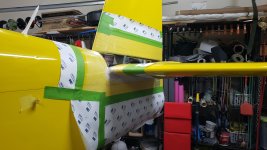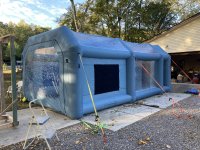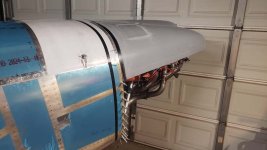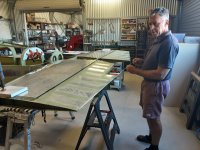Hey, look at me posting a Van's Air Force News edition on a Sunday!
The new site has been live one business day and one weekend day. Adjustments still underway regarding ad final placement, etc. Could take some time to get dialed, so your patience is appreciated. I thought it more important to get 'live' and work out the final appearance later. v/r,dr
Posts/Replies that caught my eye recently:
What did you do with your RV this weekend?
https://vansairforce.net/threads/what-did-you-do-with-your-rv-this-weekend-1-12-1-15ish.223566/

Turns out vinyl backer paper is good for something else.
It makes great mask.
By the way, clay works great till it starts to dry. Gravity! I managed to secure the clay mold before it fell off.
 vansairforce.net
vansairforce.net

RE: Aerobatics
I've been flying IAC competition aerobatics since 2016, recreational aerobatics forever. I flew 12 contests in Sportsman and dabbled in Intermediate in my RV before moving on to the Extra. I still have my RV; always will.
I agree that the minor aerodynamic improvements won't amount to anything. Speed is controlled with g and the throttle. In recreational aerobatics, I left the power at high cruise setting of 24" and 2400 rpm and performed aerobatics between 3 - 4.5 g all day long without touching anything. In competition, the power was set mostly like Oliver said, everything forward or idle. On hammerheads I would gradually bring the power back (about 1/3 throttle) during the pivot to avoid being overcome by the torque. If I had point rolls on the way down, I would leave the power back until initiating the pull out. Speed on down lines (45 or vertical) is also managed by line length.
My airplane is configured with a flop tube in the left tank, an IO-360A1A (200 hp), Christen inverted oil system, and a Hartzell constant speed prop. I never felt that I had too much energy or gained enough energy throughout a sequence to get so high that it impacted my presentation.
Oliver and others have proven that you don't "need" flop tubes, fuel injection, inverted oil, and a constant speed prop for RV Sportsman competition aerobatics. But having those accessories will make your aerobatics easier and more enjoyable. It will also allow you to things that you wouldn't be able to do otherwise. I had several Free programs with "interesting" figures that I couldn't have done without those accessories. And the best thing about the constant speed prop is the braking action. Don't underestimated the value of the acceleration and braking action especially if you're interested in formation. I have one flop tube in the left tank only. If I had to do it over, I would put two, one in each tank. The only negatives were that unusable fuel that went from 4 oz to 13 oz and the periodic required replacement of the rubber hose. Something about being in the middle of a Cuban 8 upside down pointed at the ground when you've been made aware that you forgot to select the correct tank will make you wish for dual flop tubes! The other accessory I wished I had was a ratcheting harness. If you're still building, figure out the structural changes to incorporate a ratcheting belt that has a secondary attachment point. Make it so that when you tighten the ratchets you are pulled down into the seat rather than aft. You may also have to incorporate something firm as opposed to a soft seat cushion that you sink into. The other thing is, my parachute destroyed my stock seat back. I had to remove the cushion when wearing the parachute. I've made a new an "improved" seat back, but I'm not flying competition in the RV anymore anyway. So it really doesn't matter.
Ron Schreck had a power point presentation called RV Aerobatics. It got into the hardware and other stuff. I'll see if I can find it and post it here.
I highly recommend IAC competition aerobatics. It's extremely challenging and fun. It WILL make you a better pilot. You'll make a lot of new friends. Everyone is very helpful, even your direct competitors. I always have purpose when I fly. It's changed my life. I'll be doing this until I can't do it anymore.
Jerry Esquenazi
RV-8 N84JE
 vansairforce.net
vansairforce.net
DIY Painting ...scottmillhouse
On previous planes I set up a homemade booth by putting up a temporary wall in my shop, furnace filters in window and an air lock with a couple of exhaust fans. The space has since been used so I bought one of the blow up booths. Easy to set up and works well. Did 12 wings and tail this fall with remainder planned for Spring. Only issue is that the bright Sun made it like a hot house so paint setup quicker that expected. Solution was to paint later in day when in shadow.

EGT Probe Failure ...plehrke
Timely thread as on my last flight I had my EGT probe on one cylinder rise quickly 30-50 degrees above its normal steady leaned valve and then quickly fall back down in line. It did that several times over a 30 minute flight. I swapped it with one of the other probes but not gone flying yet due to weather. No difference in appearance between the two probes.
My probes have had a hard life as I have them just 2” from the exhaust flange. My peak EGTs are in the 1500-1550 F range. JPI guy at OSH said that was OK but may not get much life out of them. that was 17 years and 1100 hours ago. I guess I was due for a probe failure.
 vansairforce.net
vansairforce.net
Trimming the Pepto ...PhatRV
There is a write up in the FWF build section. Basically you have to mark a reference line from the firewall line on your fuselage. Fit the cowl as best you can. Then use the reference line to trace the lines on the cowl for cutting. Here is a picture after the cut. The reference line is the forward edge of the tape line on the fuselage. The aft edge of the tape is left on the upper cowl.
 vansairforce.net
vansairforce.net

-14: Section 11-3 Drilling elevator horns but trailing edges are not lined up!
(PaulvS PIREP)
I also believe that it is more important for the trailing edges to be aligned than it is for the counterbalance arm positions to be matched to the HS
The instructions in the plans to align the arms would be fine if the parts were perfect, but if there is any twist in either of the elevators or the HS it's not going to work.
So I would check multiple ways to work out why there is a discrepancy. Use string lines pulled along the trailing edges of the elevators to see where they meet. It could also be done with two long straight edges. A digital level at various stations along each elevator will show up any twist. If there is any, then I would average it out and drill the horns so that the elevators are aerodynamically matched.
 vansairforce.net
vansairforce.net

And this issue's Off Topic:

The new site has been live one business day and one weekend day. Adjustments still underway regarding ad final placement, etc. Could take some time to get dialed, so your patience is appreciated. I thought it more important to get 'live' and work out the final appearance later. v/r,dr
Posts/Replies that caught my eye recently:
What did you do with your RV this weekend?
https://vansairforce.net/threads/what-did-you-do-with-your-rv-this-weekend-1-12-1-15ish.223566/
Turns out vinyl backer paper is good for something else.
It makes great mask.
By the way, clay works great till it starts to dry. Gravity! I managed to secure the clay mold before it fell off.
Empennage Fairing
The Vans fairing isn't perfect, but most of it is usable by cutting the flanges that fit on top of the HS. I will adjust them to fit then reattach them. That leaves the bottom fairing. Sorry Vans. I can do better than a strip of aluminum angle. Sweetie is a Potter. I've worked a lot of clay...

RE: Aerobatics
I've been flying IAC competition aerobatics since 2016, recreational aerobatics forever. I flew 12 contests in Sportsman and dabbled in Intermediate in my RV before moving on to the Extra. I still have my RV; always will.
I agree that the minor aerodynamic improvements won't amount to anything. Speed is controlled with g and the throttle. In recreational aerobatics, I left the power at high cruise setting of 24" and 2400 rpm and performed aerobatics between 3 - 4.5 g all day long without touching anything. In competition, the power was set mostly like Oliver said, everything forward or idle. On hammerheads I would gradually bring the power back (about 1/3 throttle) during the pivot to avoid being overcome by the torque. If I had point rolls on the way down, I would leave the power back until initiating the pull out. Speed on down lines (45 or vertical) is also managed by line length.
My airplane is configured with a flop tube in the left tank, an IO-360A1A (200 hp), Christen inverted oil system, and a Hartzell constant speed prop. I never felt that I had too much energy or gained enough energy throughout a sequence to get so high that it impacted my presentation.
Oliver and others have proven that you don't "need" flop tubes, fuel injection, inverted oil, and a constant speed prop for RV Sportsman competition aerobatics. But having those accessories will make your aerobatics easier and more enjoyable. It will also allow you to things that you wouldn't be able to do otherwise. I had several Free programs with "interesting" figures that I couldn't have done without those accessories. And the best thing about the constant speed prop is the braking action. Don't underestimated the value of the acceleration and braking action especially if you're interested in formation. I have one flop tube in the left tank only. If I had to do it over, I would put two, one in each tank. The only negatives were that unusable fuel that went from 4 oz to 13 oz and the periodic required replacement of the rubber hose. Something about being in the middle of a Cuban 8 upside down pointed at the ground when you've been made aware that you forgot to select the correct tank will make you wish for dual flop tubes! The other accessory I wished I had was a ratcheting harness. If you're still building, figure out the structural changes to incorporate a ratcheting belt that has a secondary attachment point. Make it so that when you tighten the ratchets you are pulled down into the seat rather than aft. You may also have to incorporate something firm as opposed to a soft seat cushion that you sink into. The other thing is, my parachute destroyed my stock seat back. I had to remove the cushion when wearing the parachute. I've made a new an "improved" seat back, but I'm not flying competition in the RV anymore anyway. So it really doesn't matter.
Ron Schreck had a power point presentation called RV Aerobatics. It got into the hardware and other stuff. I'll see if I can find it and post it here.
I highly recommend IAC competition aerobatics. It's extremely challenging and fun. It WILL make you a better pilot. You'll make a lot of new friends. Everyone is very helpful, even your direct competitors. I always have purpose when I fly. It's changed my life. I'll be doing this until I can't do it anymore.
Jerry Esquenazi
RV-8 N84JE
Aerobatic build considerations?
Hi! I know that the down lines are the hard part of RV-8 aerobatics, because of the speed you can reach quickly when pointing the nose directly down. I want to do sportsman level competition, and so am adding flop tubes, inverted oil, and an aerobatic prop with my injected engine. That said...
DIY Painting ...scottmillhouse
On previous planes I set up a homemade booth by putting up a temporary wall in my shop, furnace filters in window and an air lock with a couple of exhaust fans. The space has since been used so I bought one of the blow up booths. Easy to set up and works well. Did 12 wings and tail this fall with remainder planned for Spring. Only issue is that the bright Sun made it like a hot house so paint setup quicker that expected. Solution was to paint later in day when in shadow.

EGT Probe Failure ...plehrke
Timely thread as on my last flight I had my EGT probe on one cylinder rise quickly 30-50 degrees above its normal steady leaned valve and then quickly fall back down in line. It did that several times over a 30 minute flight. I swapped it with one of the other probes but not gone flying yet due to weather. No difference in appearance between the two probes.
My probes have had a hard life as I have them just 2” from the exhaust flange. My peak EGTs are in the 1500-1550 F range. JPI guy at OSH said that was OK but may not get much life out of them. that was 17 years and 1100 hours ago. I guess I was due for a probe failure.
EGT probe failure mode
The EGT on one cylinder is slow to come alive at startup and the reading fluctuates before settling down about 30 minutes into a flight and is generally in line with the other 3 cylinders. I removed all of the probes and wire brushed any corrosion off of both the probe and exhaust pipe. The...
Trimming the Pepto ...PhatRV
There is a write up in the FWF build section. Basically you have to mark a reference line from the firewall line on your fuselage. Fit the cowl as best you can. Then use the reference line to trace the lines on the cowl for cutting. Here is a picture after the cut. The reference line is the forward edge of the tape line on the fuselage. The aft edge of the tape is left on the upper cowl.
Trimming the Pepto Bismol cowl
Getting ready to fit the cowl on my RV-8. Approximately how much of the aft cowl is will need to be removed?

-14: Section 11-3 Drilling elevator horns but trailing edges are not lined up!
(PaulvS PIREP)
I also believe that it is more important for the trailing edges to be aligned than it is for the counterbalance arm positions to be matched to the HS
The instructions in the plans to align the arms would be fine if the parts were perfect, but if there is any twist in either of the elevators or the HS it's not going to work.
So I would check multiple ways to work out why there is a discrepancy. Use string lines pulled along the trailing edges of the elevators to see where they meet. It could also be done with two long straight edges. A digital level at various stations along each elevator will show up any twist. If there is any, then I would average it out and drill the horns so that the elevators are aerodynamically matched.
Section 11-3 Drilling elevator horns but trailing edges are not lined up!
I'm getting ready to drill the elevator horns (Section 11-3). I taped the elevator counterbalance arms to the horizontal stabilizer as called out in the plans. I then looked at the trailing edges. The trailing edge of the left elevator is 1/2" higher than the right! It seems to me it's more...

And this issue's Off Topic:

Last edited:

